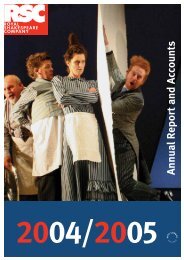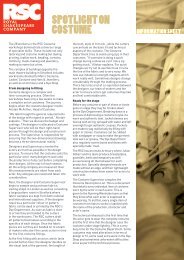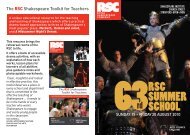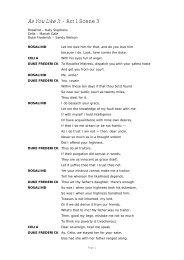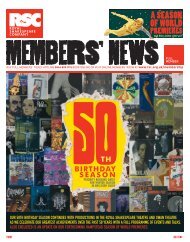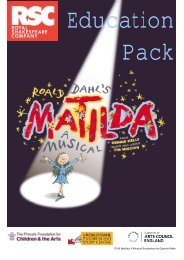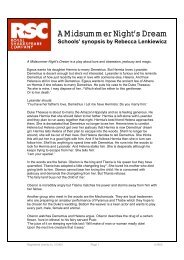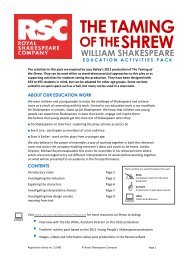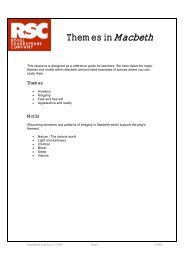Giles Cadle, set designer on The Tempest - Royal Shakespeare ...
Giles Cadle, set designer on The Tempest - Royal Shakespeare ...
Giles Cadle, set designer on The Tempest - Royal Shakespeare ...
You also want an ePaper? Increase the reach of your titles
YUMPU automatically turns print PDFs into web optimized ePapers that Google loves.
<str<strong>on</strong>g>Giles</str<strong>on</strong>g> <str<strong>on</strong>g>Cadle</str<strong>on</strong>g>, <str<strong>on</strong>g>set</str<strong>on</strong>g> <str<strong>on</strong>g>designer</str<strong>on</strong>g> <strong>on</strong> <strong>The</strong> <strong>Tempest</strong><br />
3 August 2006 – Interview by Suzanne Worthingt<strong>on</strong>, RSC Educati<strong>on</strong><br />
How did you prepare for your initial meeting with the director and the <str<strong>on</strong>g>designer</str<strong>on</strong>g>?<br />
I just read the play a few times to try and understand what it's about.<br />
So you had quite an open mind?<br />
Yes, definitely.<br />
You collaborated with Nicky and Rupert: what is useful from a director in terms of<br />
input and what would you rather they didn't do?<br />
With something like <strong>Shakespeare</strong>, it's better the director comes with a view of what they want<br />
you to do with the play because it's been d<strong>on</strong>e so many times. You need to have a vague idea<br />
of which way to go with it - otherwise you have nothing.<br />
For this producti<strong>on</strong>, Rupert said he would like to <str<strong>on</strong>g>set</str<strong>on</strong>g> it in a cold envir<strong>on</strong>ment. Some directors<br />
are very visual and some just aren't visual at all. I think it's useful to have some directi<strong>on</strong> in<br />
terms of what their view of the play is and where and what period to <str<strong>on</strong>g>set</str<strong>on</strong>g> it in.<br />
It depends what the play is. For new writing, it doesn't always need that input.<br />
How did you research your work <strong>on</strong> <strong>The</strong> <strong>Tempest</strong>?<br />
Were there any images or artists which crystallised the play for you?<br />
No. I did a lot of research around the subject to try and find images that interested me or<br />
seemed appropriate.<br />
What themes or emoti<strong>on</strong>al qualities in <strong>The</strong> <strong>Tempest</strong> did you want to draw out<br />
through the design?<br />
It was about making the island into a place where these things could happen, giving it a real<br />
sense but also a surreal sense that enabled the activities of the magical world to happen.<br />
Can you explain more about how that came out in the design? <strong>The</strong> way in which the<br />
stage works is interesting, with the curtain coming across…<br />
Yes. <strong>The</strong>re are lots of scenes in the play that had to be addressed. <strong>The</strong>y seem to take place in<br />
parts of the island but at the same time within the same locati<strong>on</strong>. So there was that to be<br />
solved. Rupert was keen <strong>on</strong> some kind of endless landscape, which is very hard to do <strong>on</strong><br />
stage. Any sort of natural object <strong>on</strong> stage doesn't look right!<br />
Like clouds painted <strong>on</strong> a sheet?!<br />
Yes – it always looks rubbish! Also there's the c<strong>on</strong>straint that this show has to play in<br />
repertoire. <strong>The</strong> floor has to break into very small pieces [so it can be moved into and out of<br />
the theatre quickly]. So you can't do a snowy floor. I was trying to take an envir<strong>on</strong>ment that<br />
at first glance looks quite naturalistic but in reality is abstract. Something that doesn't look<br />
wr<strong>on</strong>g but doesn't look right...<br />
Some people like to work <strong>on</strong> their own or use the internet or brainstorm with other<br />
people. How do you work?<br />
1
I do lots of sketches or little storyboards. It's very important to break the play down into bitesized<br />
pieces, the different scenes and people who need to be <strong>on</strong>-stage, how they might get<br />
<strong>on</strong>to the stage, the architecture of how the play might be directed, let al<strong>on</strong>e what it looks like.<br />
What it looks like is sometimes the last thing I come to.<br />
We're designing three m<strong>on</strong>ths before rehearsals start. I sketch predominantly just to get<br />
things moving very quickly, and then we build maquettes and scale models, and I do draft <strong>on</strong><br />
a computer.<br />
How do you communicate your final designs, for example to the acting company?<br />
With a model, or a photograph of a model if it's an endless number of scenes.<br />
Going back to collaborati<strong>on</strong>, how did you work with Nicky Gillibrand [the costume<br />
<str<strong>on</strong>g>designer</str<strong>on</strong>g>]? In many RSC producti<strong>on</strong>s there is <strong>on</strong>ly <strong>on</strong>e <str<strong>on</strong>g>designer</str<strong>on</strong>g> doing both the <str<strong>on</strong>g>set</str<strong>on</strong>g><br />
and the costumes. Why was the decisi<strong>on</strong> made to have both of you, and how did you<br />
work together?<br />
I've worked with Nicky many times before and I think she's the best costume <str<strong>on</strong>g>designer</str<strong>on</strong>g> in the<br />
business. I'd ask her to do everything that I do – because she can do it so much better than<br />
me! Some directors are keen to split the scenes and the costumes because doing both, it's<br />
very hard to service the director in terms of being in two places at the same time. Once<br />
you're <strong>on</strong>-stage, there's a lot of running around. I do costumes half the time when I design,<br />
and half the time I d<strong>on</strong>'t.<br />
Have you worked with Rupert before, or designed <strong>The</strong> <strong>Tempest</strong> before?<br />
No. I did A Midsummer Night's Dream at the RSC about four years ago.<br />
Did that affect the way you designed this, at all?<br />
It did a bit in terms of my view of the space and how powerful you can make things look <strong>on</strong><br />
that stage [the <strong>Royal</strong> <strong>Shakespeare</strong> <strong>The</strong>atre]. It's a very difficult stage.<br />
In terms of staging a play, you can update the c<strong>on</strong>text for a c<strong>on</strong>temporary audience.<br />
But the <str<strong>on</strong>g>set</str<strong>on</strong>g>ting for this producti<strong>on</strong> is both familiar and strange at the same time.<br />
How did you and Rupert arrive at that? Or was it all Rupert's idea?<br />
Yes and no. My view <strong>on</strong> period costumes or period <str<strong>on</strong>g>set</str<strong>on</strong>g>tings is that sometimes I find them a<br />
distracti<strong>on</strong>, they d<strong>on</strong>'t let you into the play. I d<strong>on</strong>'t mean that you have to update the play<br />
just for the sake of it but you need to have some understanding of why people are doing<br />
things or what their acti<strong>on</strong>s are and not see it as some kind of museum piece.<br />
You mean they look like they're in fancy-dress?<br />
Yes. Sometimes it's valid and it works very well but I find it quite hard to watch people in<br />
tights - I can't take them seriously!<br />
It's always about finding a language in which you can communicate things. Sometimes ultramodern<br />
is equally problematic because then you have to make comment about the<br />
envir<strong>on</strong>ment in which it's <str<strong>on</strong>g>set</str<strong>on</strong>g>.<br />
You talked before about abstracti<strong>on</strong> versus naturalism - Rupert wanted the <str<strong>on</strong>g>set</str<strong>on</strong>g> to<br />
look natural – but how?<br />
Not natural... he wanted a 'tremendous expanse'.<br />
2
Some scenes aren't particularly abstract, for example the scenes in the cabin…<br />
<strong>The</strong> space itself is abstract. Where do you stop building? Do you build the whole boat or do<br />
you just build a suggesti<strong>on</strong> of the boat? It's always, 'At what point do we stop the<br />
abstracti<strong>on</strong>?' It's relative.<br />
At the beginning of the play, the <str<strong>on</strong>g>set</str<strong>on</strong>g> give you the sense of being in a cinema. How<br />
did you come up with that idea?<br />
We [Rupert and I] both liked the idea of a nightmare – it's a nightmarish play, strange things<br />
happen and it does feel a bit like <strong>on</strong>e of those scary Hitchcock movies. So we started off with<br />
that c<strong>on</strong>text. <strong>The</strong> play almost starts twice: with the storm, then it starts again with everybody<br />
arriving at the island. <strong>The</strong> storm is almost like a trailer to the play, so we thought we could<br />
divide the two.<br />
Why did you decide to use video projecti<strong>on</strong> in the producti<strong>on</strong>?<br />
You have to change the scenes quickly. We use a wipe device, just a curtain passed in fr<strong>on</strong>t of<br />
the stage. It's very filmic, and in order to make it look a bit more interesting, not just a black<br />
object, we used video.<br />
Lorna Heavey [the video <str<strong>on</strong>g>designer</str<strong>on</strong>g>] animated the curtain in a beautiful way. It took a l<strong>on</strong>g<br />
time to fine-tune. It's not an easy thing that you can alter quickly. It developed over a period<br />
of time. It's something that you note, take away, come back to... and hope things haven't<br />
changed in the time between!<br />
To finish, a few biographical questi<strong>on</strong>s. So how did you train to do this job?<br />
I did a degree in architecture and then…<br />
Seven years?!<br />
No I did the degree in three years. And then I did a post-grad in theatre design.<br />
Did you always want to do that or at some point in the degree did you think, 'Hmm,<br />
maybe I d<strong>on</strong>'t want to do buildings'?<br />
Having completed the degree and starting to work as a very junior architect, it wasn't quite<br />
what I wanted to do. In the last couple of years of doing architecture, I started going to the<br />
theatre a lot and I got interested in it.<br />
So you transferred it with a post-grad?<br />
Yes I went to look at some post-grad courses, not with an intenti<strong>on</strong> of doing <strong>on</strong>e, but while<br />
looking I was offered a place to start the following week. I think somebody just dropped out<br />
or something! I filled the place.<br />
How did you get from a post-grad to the RSC?<br />
<strong>The</strong>re's no direct route, it's not like being an apprentice and then becoming a master. I<br />
worked as an assistant to a <str<strong>on</strong>g>designer</str<strong>on</strong>g> for a few years and from that, I met directors and other<br />
people and slowly got more of my own work. Within that there are, of course, breaks that you<br />
get. But I think you make your own luck.<br />
Finally – what was the most challenging aspect of designing <strong>The</strong> <strong>Tempest</strong>?<br />
3
All of it!<br />
Transcripti<strong>on</strong> by Veryan Boorman<br />
Edited by Suzanne Worthingt<strong>on</strong><br />
4



